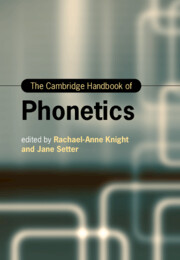Book contents
- The Cambridge Handbook of Phonetics
- Cambridge Handbooks in Language and Linguistics
- The Cambridge Handbook of Phonetics
- Copyright page
- Contents
- Figures
- Tables
- Contributors
- Introduction
- Section I Segmental Production
- Section II Prosodic Production
- Section III Measuring Speech
- Section IV Audition and Perception
- 16 Neurological Foundations of Phonetic Sciences
- 17 Psycholinguistic Aspects
- 18 Phonetics and Eye-Tracking
- 19 Automatic Speech Recognition by Machines
- Section V Applications of Phonetics
- Index
- References
16 - Neurological Foundations of Phonetic Sciences
from Section IV - Audition and Perception
Published online by Cambridge University Press: 11 November 2021
- The Cambridge Handbook of Phonetics
- Cambridge Handbooks in Language and Linguistics
- The Cambridge Handbook of Phonetics
- Copyright page
- Contents
- Figures
- Tables
- Contributors
- Introduction
- Section I Segmental Production
- Section II Prosodic Production
- Section III Measuring Speech
- Section IV Audition and Perception
- 16 Neurological Foundations of Phonetic Sciences
- 17 Psycholinguistic Aspects
- 18 Phonetics and Eye-Tracking
- 19 Automatic Speech Recognition by Machines
- Section V Applications of Phonetics
- Index
- References
Summary
In this chapter, we provide a historical and a contemporary overview of the hearing brain. We will review how various brain-imaging methods are employed to study how sounds and meanings are represented in the brain. These studies have provided the foundation from which network models of the brain are built. We will conclude with a discussion of the practical aspects of the neuroscience of language, such as how it will further our understanding of the brain and lead to clinical applications.
- Type
- Chapter
- Information
- The Cambridge Handbook of Phonetics , pp. 407 - 429Publisher: Cambridge University PressPrint publication year: 2021



